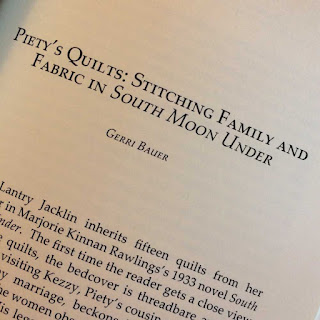 |
| My article about the meaning of quilts in South Moon Under is in the 2018 Marjorie Kinnan Rawlings Journal of Florida Literature, vol 26. (Gerri Bauer photo) |
Florida in the 1920s and 1930s was filled with hidden backwoods homesteads.
The frenzied activity of the era's Florida Land Boom may well have been on another planet for anyone visiting these pioneer settlements. One such visitor was author Marjorie Kinnan Rawlings.
Rawlings moved to Florida in 1928. As part of her research, she trekked into the Florida scrub near Ocala to live with a Cracker family named Fiddia in 1931.
Her experiences and meticulous notes evolved into her 1933 novel, South Moon Under, which was a finalist for the Pulitzer Prize. (Her best-known novel, The Yearling, won the Pulitzer in 1939.)
South Moon Under is my favorite Rawlings' novel, not least because a thread about quilting runs through it, as hidden as those old homesteads were. More about that later. This blog post is now going to split into two threads, no pun intended.
One thread highlights a video featuring the granddaughter of the woman Rawlings stayed with in the Ocala forest. The other is about the novel's quilting aspect and about the article in which I explore quilting's place in the narrative. The article is published in the 2018 issue of The Marjorie Kinnan Rawlings Journal of Florida Literature, Volume 26. The journal is published by the Marjorie Kinnan Rawlings Society, of which I'm a member.
Rawlings' hosts in the forest were Piety Fiddia and her son. Rawlings learned about and tried her hand at many aspects of the Fiddias' self-sufficient pioneer life. She then gave the name Piety to the fictional mother in South Moon Under.
The real Piety's granddaughter, Carol Fiddia Laxton, said Rawlings' writing captured her grandmother so perfectly, she could almost see her on the pages of the novel.
That comment, and others about life in pioneer Florida and Carol's childhood memories of Rawlings, are in the wonderful video linked below. The video was filmed at Marjorie Kinnan Rawlings Historic State Park in Cross Creek and was sponsored by the Friends of Marjorie Kinnan Rawlings Farm.
Back to the novel and its quilts: My curiosity about the bedcovers' role was sparked the first time I read the book years ago, but went dormant. About three years ago, I re-read the novel and the quilting again jumped out at me. I knew I wanted to write about it, but why? What did the quilting signify and why was it featured enough in the narrative for me to notice?
Rawlings didn't use words indiscriminately but she did use metaphors. I let my ideas percolate for several months and periodically did some research, but still came up empty.
Then my mother fell gravely ill, and I started driving back and forth through the Ocala National Forest two, sometimes three, times a week. My mother died and the trips continued as I settled her estate, relocated my ill father to DeLand near my husband and me, and sold my parents' Ocala house.
This was an emotionally hard time for me, as you can guess. Each time I drove, the forest portion of my journey soothed my psyche. And each time, I'd think of the novel and the quilting, especially when I passed the sign for the Big Scrub turnoff. The road leads to a now-abandoned homestead that once inspired Rawlings' writing.
I'd see the sign, think of the author, think of the novel, and circle back to quilts. For I come from a long line of women who plied the needle, sometimes to keep themselves and their families alive. They sewed as peasants in Europe and in sweatshops in New York City, not as Crackers in the Florida scrub. But some things transcend physical boundaries.
On my drives, I thought about mothers and daughters, needlework, communities, connections, so many things. And one day, on one of those drives, the missing link I sought was ... just there, in my mind.
I had just passed State Road 19 and noted one of my journey's landmark sandhills as I rounded a curve. Before I reached the Big Scrub sign the answer came to me in a flash. The quilting in the novel connects women. It helps the fictional Piety thread her extended family together in a way that ensures survival in the scrub beyond basic necessities.
Finally, I was able to write the article that became "Piety's Quilts: Stitching Family and Fabric in South Moon Under." Finally, the meaning of the quilts was clear.
Quilting is a multifaceted art and craft in the 21st century. It encompasses all genders, a range of genres and applications, and collective endeavors such as the NAMES Project AIDS Memorial Quilt, which I was privileged to see about 20 years ago.
But in the story world of South Moon Under and in the daily life I try to uncover in this blog, quilting was part of the pioneer woman's domain. It was something that gave her agency. And that's important no matter what the era.
Here's the video:
 |
Watch the video at https://youtu.be/jI4IsV6chR4 |

No comments:
Post a Comment